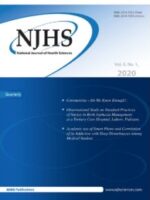The COVID-19: Yet another Viral Spill-Over of Unexpected Consequences
Samina Naz Mukry
The human coronaviruses (CoV) are the causative agent of respiratory illness in human especially during winter and fall. They were first identified in 1960’s. The four corona strains
i.e. NL63, 229E, HKU1 and OC63 accounts for about 30% of the annual common cold incidences ranging from mild to moderate illness in human worldwide.
Received: February 18, 2020
Revised: May 08, 2020
Accepted: May 11, 2020
doi.org/10.21089/njhs.51.0001
Comparative Prevalence of Intestinal Helminths in Satar and Chaudhary Communities of Birtamode Municipality, Jhapa, Nepal
Shanti Chaudhary and Janak Raj Subedi
Abstract: Introduction: Intestinal parasitic infections remain a major public health problem in many parts of the world, particularly in low and middle-income countries like Nepal.
Received: February 02, 2020
Revised: May 13, 2020
Accepted: May 15, 2020
doi.org/10.21089/njhs.51.0004
Academic Use of Smart Phone and Correlation of its Addiction with Sleep Disturbances Among Medical Students
Javeria Mansoor, Sindhu Muneer, Loyala Kanwal
Abstract: Objective: To assess the positive academic usage of smart phone to determine the correlation of its potential addiction with sleeping disturbances among medical students in Karachi, Pakistan.
Received: September 17, 2019
Revised: January 02, 2020
Accepted: January 13, 2020
doi.org/10.21089/njhs.51.0013
Correlation of Neurological Deficits in Patients with Myelomeningocele on the Basis of Anatomical Location and Size of Base of Defect
Muhammad Kashif Bashir, Aisha Ishtiaq, Aisha Javeed
Abstract: Aims and Objectives: To analyze data regarding relationship of myelomeningocele at different anatomical locations along vertebral canal and size of base defect.
Received: January 24, 2020
Revised: April 26, 2020
Accepted: April 28, 2020
doi.org/10.21089/njhs.51.0019
Observational Study on Standard Practices Of Nurses in Birth Asphaxia Management at a Tertiary Care Hospital, Lahore, Pakistan
Sana Noor, Kousar Praveen, Muhammad Hussain, Muhammad Afzal, Syed Amir Gilani
Abstract: Background: Neonatal mortality is the death of newborn baby in first 28 days of life. Approximately 1 million newborn die in early 24 hours and 2 million more will be die in next 7 days of birth. Birth asphyxia is a medical condition which results due to lack of oxygen to newborn and last for long time, causing different morbidities and physical harm. It is the third major cause of newborn death, according to world health organization.
Received: April 12, 2020
Revised: May 17, 2020
Accepted: May 18, 2020
doi.org/10.21089/njhs.51.0024
Factors Affecting Health Seeking Behavior and Health Services in Pakistan
Khudija Mushtaq, Muhammad Hussain, Muhammad Afzal, Syed Amir Gilani
Abstract: Health seeking practices and well-being management has been considered and the determinants are divided into physical, financial, social and political environments. Health knowledge as well as the activities is the key elements that ensure high quality of health. The audit found clear practices that pursue differences in sexual orientation, social conditions, infection occurrences and family economic conditions. In this way, an evidence-based approach must be planned by establishing an understanding of the way happiness practices and social insurance are used, and giving enough credibility to all determinants. By focusing on the benefits (network) factors caused by environment, financial variables, training levels, social beliefs and the human service framework itself, it is feasible to improve the requirements for the use of solid behavior and physical medical services. Men are considered to be the main head of a family. Men’s instruction level is considered higher than women because men are dominant in our society.
Received: November 18, 2019
Revised: December 27, 2019
Accepted: December 31, 2019
doi.org/10.21089/njhs.51.0030
Health Care Delivery System of Pakistan and Bangladesh: A Comparative Analysis
Khudija Mushtaq, Muhammad Hussain, Muhammad Afzal, Syed Amir Gilani
Abstract: Health care delivery system is fair distribution, organization, and arrangement of health resources that serves best for any country’s population efficiently and effectively for the achievement of organizational goals. Health care services are the multiple services providing to an individual, families, and communities by health care providers who are skilled to prevent disease, promote health, cure illness for the purpose of maintaining and restoring good health. Human development and economic solidarity can be increased ultimately due to better health that labor of a country. Productive human capital resources and healthy labor force can be achieved by planned healthcare services by the government for its people. Worldwide, health regions contrasts from country to country, it depends on how much costs on health is been efficiently utilized. The primary contributors in health care services are private health sectors, donors, out of pocket expenditures in the most of developing countries which may increase human capital and economic growth of the country as, public health sectors remains deprived due to structural fragmentation, lack of resources, and functional inabilities. In this article we discuss about the healthcare delivery system of Pakistan versus Bangladesh such as organizational structure, analysis of both the healthcare systems, and some recommendations to improve healthcare reform and its application.
Received: November 26, 2019
Revised: March 18, 2020
Accepted: April 08, 2020
doi.org/10.21089/njhs.51.0035
Coronavirus – Do We Know Enough?
Shahzad Ali Jiskani
Abstract: Coronavirus 2019 (COVID-19), previously called as 2019-nCoV, was emerged from Wuhan, China in December 2019. It is caused by Severe Acute Respiratory Syndrome Coronavirus 2 (SARS-CoV-2). By 22 March 2020, 323,265 people were infected from this virus, including 13,745 deaths globally. It is declared as pandemic by World Health Organization as it involved 185 countries of the world. World Health Organization also declared it as 6th public health emergency of international concern. COVID-19 presents as various outcomes; asymptomatic (carrier), pneumonia and acute respiratory disease. People of all ages can be affected from this virus but adult population is observed to be involved in high ratio. Additionally, there is possibility that infection can be spread as nosocomial infection to patients and healthcare workers. On chest imaging, ground – glass opacity with bilateral involvement is seen as most common abnormality in patients with pneumonia. Older patients are prone to develop more severe disease as compared to young population. Patients with underlying chronic co-morbidities are also more prone to develop poor outcome. Till now, specific treatment of COVID-19 is not available; however clinical trials are under investigation to see the clinical efficacy of various therapeutic agents in China e.g. remdesivir and chloroquine etc. At this time, standard infection control measures are only possible means for prevention of SARS-CoV-2.
Received: March 24, 2020
Revised: May 14, 2020
Accepted: May 15, 2020
doi.org/10.21089/njhs.51.0042
Response to a Research Article Entitled: Prevalence of Lactose Intolerance and its Association with Malnutrition in Children
Dear Editor,
With clearly outlined prospects for research, I congratulate Dr. Neel Kanth and colleagues for their interesting study on the “Prevalence of lactose intolerance and its association with malnutrition in children”, published in a recent issue of the National Journal of Health Sciences (NJHS, Volume 4, Issue 3, 2019) [1]. The high prevalence of lactose intolerance documented by the authors is confirmed by a recent meta-analysis, which found a lactose malabsorption among adults and children aged 10 years or older of 58% in Pakistan [2]. The 2018 Pakistan National Nutrition Survey also showed that 40.2% children were stunned, 28.9% were underweight, and 17.7% were wasted [3]. The authors rightly pointed out that further research is urgently needed to better understand the association of lactose intolerance and malnutrition in children [1]. However, in my opinion, here are two aspects worth mentioning.
Dates for Letter to Editor:
Received: March 03, 2020
Approved: May 08, 2020
Dates for Response to Letter:
Received: June 06, 2020
Approved: June 15, 2020
doi.org/10.21089/njhs.51.0053

VOL. 5, NO. 1, 2020
